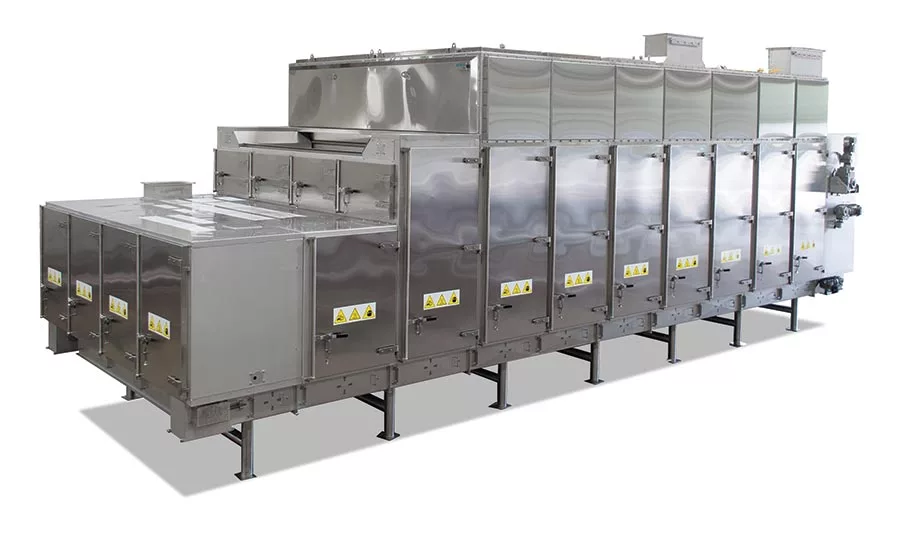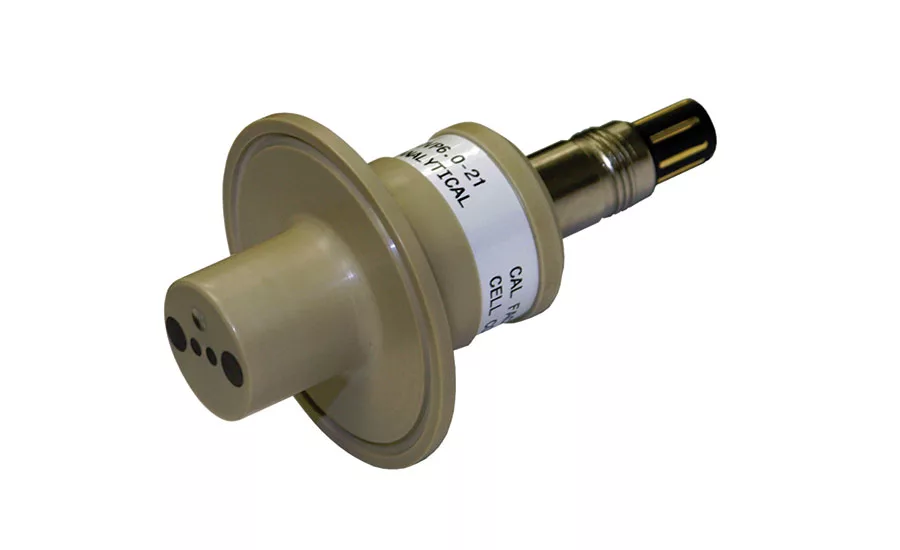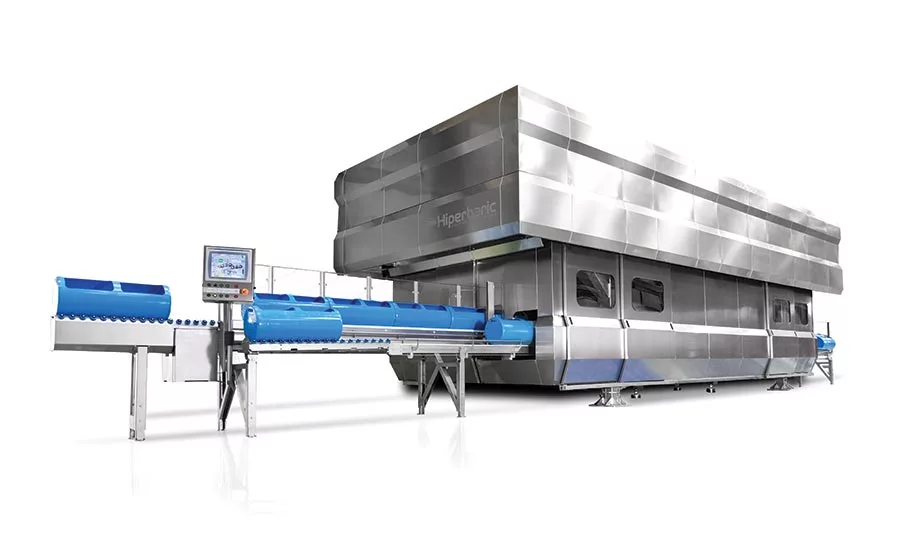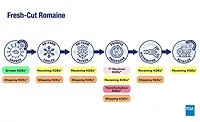Complying with FSMA for pet food manufacturing

Subjecting raw meats to HPP inactivates pathogens. HPP can be applied to raw ingredients or final products to make them safe for pets to eat and humans to handle.
Photo courtesy of Universal Pure

Bühler Aeroglide’s Solis dryer features a dual plenum airflow that ensures a uniform moisture content at the dryer exit. The multi-pass design reduces floor space requirements, and gentle treatment throughout the drying process means a higher quality product and a higher yield.
Photo courtesy of Bühler Aeroglide

GEA’s high-speed vertical twin-tube SmartPacker is suited for packaging small-sized treats/snacks (e.g. nuts, dried fruits, candy) for humans, but can be used to package small, dry pet treats, keeping them fresh. It can process up to 500 bags per minute, weighing 10 to 18 grams each.
Photo courtesy of GEA

Emerson Rosemount conductivity sensors, such as the Model 410VP-PUR-Sense, can be used to continuously monitor for the proper concentration of CIP solutions in human or pet food applications.
Photo courtesy of Emerson

With a 525 liter capacity and large 380 mm container diameter, the Hiperbaric Model 525 HPP system inactivates bacteria in human and animal food and provides throughputs of over 3,000 kg of product per hour.
Photo courtesy of Hiperbaric
Bad news first: If you make pet food, have an older facility and have been putting off examining your operation in light of FSMA, rushing to comply with the new food safety rules for animal foods is probably proving to be a challenge.
Good news: If you have a newer pet food facility and/or have been evaluating your entire process and doing a gap analysis, complying with FSMA probably isn’t so onerous. With proper due diligence, compliance might even be a no-brainer.
For those who are lagging a little behind on compliance and haven’t yet had an FDA audit, there is more good news. Because most architects, engineers, system integrators (SIs) and machine/equipment builders have had a lot of experience in designing buildings, equipment and process instrumentation to comply with FSMA for human food, they’ve already built up a wealth of knowledge and experience that easily carries over into pet food manufacturing applications. And, they stand ready to help.
On the subject of compliance, it’s important to note that since animal and pet food processors now have the FSMA Preventive Controls for Animal Foods (PCAF) rule (and earlier rules covered in the Federal Food, Drug & Cosmetic Act) to live by, FDA has thrown out three out-of-date Compliance Policy Guides (CPGs) that covered enforcement policies that FDA specified for materials used in animal foods.
The three no-longer-effective CPGs were thrown out on April 30 of this year and include:
- Compliance Policy Guide Sec. 675.400 Rendered Animal Feed Ingredients
- Compliance Policy Guide Sec. 690.300 Canned Pet Food
- Compliance Policy Guide Sec. 690.500 Uncooked Meat for Animal Food
In addition, Compliance Policy Guide Sec. 665.200 Checklist Labeling for Custom Mixed Medicated Feeds was withdrawn as of July 23, 2019.
Time’s up for PCAF compliance
While FSMA compliance dates for animal food plants lagged behind their human food counterparts, all animal food compliance dates have come and gone. For small businesses/facilities, Sept. 17, 2018, was the final date to comply with the preventive controls requirements mandated by FSMA. Facilities that are large businesses were required to comply by September 2017. Large businesses are those with 500 or more full-time equivalent employees, and small businesses are those with fewer than 500 employees.
The compliance dates for the Preventive Controls (PC) and current Good Manufacturing Practice (cGMP) requirements were staggered for animal food companies. Facilities that are large and small businesses had to meet cGMP requirements earlier—by September 2016 and September 2017, respectively.
Facilities that are very small animal food businesses were also required to comply with cGMPs by the Sept. 17, 2018, deadline. Very small businesses are those averaging less than $2.5 million per year in sales plus the market value of the animal food they make or hold. These facilities are exempt from the full PC requirements, but they have an additional year to meet the requirements applicable to qualified facilities—which means that by the time you read this, the deadline will have passed.
“For animal food, both the cGMP and preventive controls requirements are new,” says Jenny Murphy, a consumer safety officer at FDA’s Center for Veterinary Medicine. “Animal foods have been regulated for years at the state and federal levels in various ways, including provisions for medicated feed, labeling and adulteration. But this is the first time that there’s been this kind of comprehensive oversight on the preventive side, and we did not have the longstanding cGMPs for animal food that we did for human food.”
cGMPs are a helpful foundation to have in place before establishing PCs, says Murphy. cGMPs are more basic; they’re things that should be done in the course of normal business, for example, proper cleaning, pest management and maintenance of equipment. cGMPs establish a base to prevent contamination of animal food, and preventive controls take it a step further to make sure that there is nothing in the food that could be a public health concern.
Problematic pet food ingredients and health
When I first heard about FSMA for animal food some years back, I thought to myself, why all the fuss? Having grown up on a farm with thousands of chickens and one cow plus four German shepherds, I wouldn’t exactly have called the dogs picky eaters—in fact, they ate most everything and never got sick. So what’s the issue—besides our pets’ health? Well, it’s our health, too.
After all, FSMA is trying to prevent the problems that apparently are still prevalent in Europe. A recent article in ScienceNews, entitled “High levels of potentially harmful bacteria found in raw meat dog food products,” reported dangerously high levels of bacteria in many raw dog food products—enough bacteria to pose potential health risks to both animals and people.
Low levels of pathogenic bacteria may be found naturally in raw meat/poultry and are not typically harmful to dogs and cats, says Mark Fleck, technical consultant at Universal Pure, a provider of HPP (high pressure processing) services. However, cross-contamination is a potential concern to humans who are in contact with their pets. HPP is one method that can be applied to raw pet food to make it safe to handle.
Generally speaking, FSMA compliance is a recognition that pet food has to be manufactured as though human consumption is a possibility, says Jeff Ewart, R.A., LEED AP BD&C, Hixson Architecture & Engineering. This drives regulating pet food in much the same manner as human food. Some of today’s pet food companies recognized this need early and have already been moving toward FSMA, but many are somewhere less than that in terms of separation of spaces within the building, equipment and operations.
The pet food marketplace itself is creating new problems, says Gerardo Morantes, Bühler director of food safety. Continued industry efforts to innovate with new products are bringing into the picture a wide array of higher risk ingredients that challenge the boundaries of process limits and good manufacturing practices required to manage appropriately the food safety risk involved.
“No one should be relaxed about raw ingredients!” says John Parraga, process specialist, ECS Solutions, a Control System Integrators Association Certified Member. All products should be manufactured as if your own pets and family are going to consume the products made with these materials. Raw materials should be tested—not just for their purity, but also for their composition; this can allow manufacturers to fine tune their recipes’ parameters based on ingredients’ properties.
“I find pet food production more challenging just because of the type of ingredients that can be utilized in the manufacturing of pet foods ... Therefore, pet food manufacturers should be held accountable to a higher standard, closer to the preventive controls rule for human food.”
– Gerardo Morantes
“I find pet food production more challenging just because of the type of ingredients that can be utilized in the manufacturing of pet foods, such as fresh meats and animal co-products from the poultry and beef industry, which bring an added level of risk into the plant when compared with low-moisture ingredients,” says Morantes.
“Therefore, pet food manufacturers should be held accountable to a higher standard, closer to the preventive controls rule for human food—given that the risk of pet food being manipulated by small children and elderly segments of the population (considered more susceptible to microbial risk) is higher in our households,” adds Morantes.
“Our mission is the same as in human food—to provide safe foods without compromising the nutritional and sensory qualities,” says Dr. Vinicio Serment, Hiperbaric USA applications manager. Secondary to the mission is to ensure pet and human safety, since pet owners’ health may be indirectly compromised by accidentally transferring pathogens to utensils, home surfaces, or even their own bodies while handling contaminated pet food.
Architects, engineers, machine builders know the ropes
“While animal food manufacturers aren’t unfamiliar with regulations, they may find the introduction of new federal regulations daunting,” says Ib Elandaloussi, assistant chemical engineer for Burns & McDonnell, Food & Consumer Products. Animal food producers have had to comply with the 1938 Federal Drug and Cosmetic Act to market safe products; however, actual production was often self-regulated. “FSMA brings to bear comprehensive policy that regulates finished pet food, treats and their ingredients. Compliance requires cGMPs, food hazards analysis and a detailed food safety plan,” adds Elandaloussi.
Equipment suppliers like Bühler can help processors address FSMA compliance. “This includes a wide range of options that begin by understanding the intended application of the products being manufactured, the ingredient selection available to our customers, and their food safety risk assessment, so that we have a common understanding of the hazards that need to be addressed by the process,” says Morantes.
This is complemented by the use of hygienic design principles not only for the equipment but also for the facility, coupled with equipment food contact material compliance, and proper understanding of the facility’s risks to ensure adequate commissioning of the equipment that supports the preventative controls implementation strategy, established by the customer’s food safety team, adds Morantes.
One way Burns & McDonnell is helping both animal and human food manufacturers is through conducting a FSMA gap assessment that identifies areas of non-conformance. “We then work with them to devise an execution plan based on risk and cost to identify and prioritize the most critical items to address,” adds Elandaloussi. “We also help develop plant and design criteria that meet sanitary design principles according to FDA requirements.”
CRB developed a FSMA Readiness Program as FSMA reform swept through the industry, says CRB Senior Process Engineer Matthew Beier. “Moving forward, we have continued to assist manufacturers by auditing their facilities against FSMA guidelines. Once an audit is performed, our team issues a report that outlines the compliant areas and any areas that fall short of full compliance or [are] out of compliance.”
CRB’s report is not confined to design requirements, but can also include procedural issues that came to light during the investigation. Both short- and long-term recommendations are made for out-of-compliance issues. Often CRB will work with processors to bring a facility into compliance.
Pet food equipment/process design follow human food
“Our typical design services for pet food clients are no different than those we provide for our human food producing customers,” says Sam Thurber, PMP, senior project manager, SSOE Group/Food and Consumer Products. “We adhere to cGMP, SQF and the new FSMA standards. Our standard project approach includes a discussion regarding hazard analysis and associated preventive controls required for new/upgraded production lines, as well as any desired data acquisition and reporting to assist our clients with their oversight and management of their preventive controls.”
Equipment design and construction have aligned to follow requirements set forth for human-grade food production, and much of the equipment now used in the production of pet food is cross-functional in human food facilities, says Drew Goodall, manager, process, GraySolutions. Owners are now investing similar amounts in process controls and automation to allow for increased online non-compliance monitoring. Engineering and design teams also now work proactively with operations’ teams to develop the required policies and procedures for the management of food safety compliance regulations.
“The equipment that we supply to the pet food industry today has changed dramatically over the last few years,” says Bühler’s Steve Blackowiak, director of R&D and food safety. Not all that long ago pet food dryers were often supplied with a high-carbon, 400 series stainless steel (SS), or even painted carbon steel. Stitch welding was commonplace and there was little concern for food safety or hygienic design. “Today, our pet food customers demand the same level of food safety as our human food customers,” adds Blackowiak.
While Dan Collins, regional technical director for McCloud Services, notes that most modern pet food plants do not differ much, if at all, from their human food counterparts, one design issue that sometimes crops up from an insect vulnerability and ease-of-cleaning perspective relates to equipment design. For example, large equipment such as dryers should be elevated at least 24 inches above the floor and 36 inches away from walls to allow for detail cleaning. In addition, the equipment should have minimal flat surfaces to prevent product from accumulating on hard-to-clean ledges.
Speaking of surfaces, surface finishes for instrumentation in the pet food environment will still be very important, according to Joshua Friesz, Emerson Automation Solutions global product manager. One common requirement for instrumentation will likely be minimum surface finishes on process wetted materials (e.g.: Ra < 32 µ-in) and/or certification to a known hygienic standard (3-A, EHEDG (European Hygienic Engineering Design Group), etc.) These are traditionally seen as entry-level requirements to make sure the instrumentation is fully cleanable and meets strict hygienic standards.
Just as automation is playing a bigger role in human food plants, expect the same in pet food facilities, adds Friesz. Continuously monitoring flow, level, pressure and other variables like pH and conductivity will not only be important for process monitoring, but also making sure that CIP has been effective. Conductivity sensors can be used to measure the concentration of CIP solutions; thereby monitoring the concentration and potency of the CIP solution, says Friesz.
In terms of automation, look for batch to play a major role in maintaining pet food quality. “We have been implementing batch processes for the past 25+ years,” says ECS’ Parraga. “The automation offerings for the distinct types of industries have been very similar due to off-the-shelf products that enable much of the functionality required—from pharmaceuticals to food and beverage to chemicals and animal feed.” Any difference comes from the customers’ requirements (i.e., some are not interested in implementing recipe life cycle management or material traceability).
Hygienic equipment design
One of the challenges with pet food equipment is that the process has an inherent risk, says Bühler’s Blackowiak. Pet foods and treats include animal-based products, which are at risk of contamination with Salmonella or other organisms. “Because of these risks we must pay particular attention to the hygienic design and avoid cleaning solutions which include the use of water,” says Blackowiak.
But should pet food equipment design be different than that intended for human food? In general, Bühler follows the principles for the manufacturing of hygienically designed equipment (the EHEDG guidelines are one example), says Morantes. Those principles are based on the food safety risk involved in the products being manufactured. They are as stringent as the risk being addressed, rather than differentiating human versus pet food.
“We do not see any difference between our equipment supplied to the pet food versus human food [processors]—it is all food and the same guidelines apply,” says Blackowiak. One good example of an existing guideline which was developed in collaboration with OEM’s and the food industry, including major pet food companies, is the “One Voice for Hygienic Equipment Design for Low Moisture Foods.” Bühler was an active participant in the development of this guideline, which can be found on the OpX Engineering Solutions Group website.
The equipment used for production of pet foods in most cases is the nearly the same equipment utilized to make human food, says CRB’s Beier. Most pet food is produced using an extruder and these same, or slightly modified, extruders are also used to make human food. Most of the downstream equipment is also the same, including coolers, ovens, coaters and packaging equipment. Wet canned pet food is produced using equipment that could just as easily be used for canning peaches, meat products or many other human food products. The equipment is designed to be easily cleaned, sanitized and maintained in a hygienic manner. Bacteria, molds and fungi do not care if the machine is producing human food or pet food.
In the case of HPP, the equipment is the same for both human and pet food, says Hiperbaric’s Serment. The product is still processed in its final packaging, and pressure transmission is uniform and instantaneous regardless of its shape or size.
From a food safety perspective, regardless of whether it is for human food or pet food, robots can be designed to prevent bacteria buildup, says Nelson Leite, JMP Solutions business development manager, automation. Robots are easy to clean in high temperatures, and they do not collect dust, preventing food contamination. Also, having a hygienically safe operating environment includes the adequate maintenance of equipment and utensils used within the processing areas and the use of suitable chemicals within and around the plant. Speaking of cleaning, robots can actually clean up after themselves. See “Scratch my back, and I’ll scratch yours,” FE Engineering R&D, November 2014.
The equipment should always be tailored to the specifics of the product/process; however, the machine is the same, says SSOE’s Thurber. The tailoring is based on whether it’s pet or human food. Whether a vertical bagger is handling dry pet food or cereal, the machine will be the same and built to the same standards. For example, it should use cleanable non-rusting SS for food contact surfaces.
FSMA and facility design
Seeing how risky pet food manufacturing can be, Bühler’s Morantes emphasizes that both equipment and plant design have to match the level of risk involved from the ingredients used, and the hygienic approach to mitigate the risk all the way through packaging and transportation.
Whether it is a human wet food facility, wet pet food, cereal production, pet kibble or any other type, the same sanitary challenges exist, says CRB’s Beier. As said earlier, mold, fungi, etc. don’t discriminate. They’ll grow where the surroundings are agreeable. FSMA enforces the proper sanitation, kill steps and product quality standards through required procedures, documentation, inspections, hazard identification, documented corrective actions and robust recall procedures.
While FSMA imposes the same requirements on human and pet food facilities, a sticking point is the requirement for hygienic zoning, raw/RTE separations and materials of construction specifications, says GraySolutions’ Goodall.
Many of these plants have not historically had good separation of spaces, says Hixson’s Ewart. To comply with FSMA and control contamination (assuming they have meat products), spaces need to be separated physically, environmentally, etc. Hixson recommends treating pet food facilities in the same manner as human food facilities in terms of regulations for segregated spaces.
As with human food plant design, wet washdown areas will use more SS, not only for the equipment, but also for any surface that requires regular wet cleaning, including walls, electrical conduit, HVAC hoods/ductwork and even floor drains, says Ed Gerken, PMP, LEED AP, product manager for SSOE. FSMA has elevated the awareness of the facility materials of construction and their impact to potential contamination—the same awareness the human food industry has experienced for the last 20 years.
For many manufacturers, not only are the regulations themselves onerous, there are considerations as to how existing facilities can accommodate physical changes and comply with new laws, says Burns & McDonnell’s Elandaloussi. Besides reworking the logistics of the day-to-day manufacturing process, pet food suppliers must consider how sanitation can be achieved, what capital requirements are needed and what actions should be prioritized. Food safety consultants can provide advice on what exactly is needed to comply with FSMA. However, to meet strict time frames and adhere to limited budgets, pet food manufacturers would benefit from specialized guidance from facility engineers who are familiar with FSMA, perform gap analyses and can create action plans to mitigate risks while minimizing expenses to bring a plant up to the levels needed for compliance.
Sidebar: Lethality processing revisited and improved
Following standard cooking procedures is critical in a lethality process. Procedures need to be enforced, and data captured can confirm that the specified length of time and temperature have been met in the cooking process. However, this method can be improved.
Cooking, or thermally processing, typically involves heating the product to a pre-determined temperature and holding the temperature for a minimum length of time. But, how variable is this process? The temperature varies with different equipment and can affect the desired result. The choice of “starting time” is another variable, which may be taken to be: when the desired temperature is reached—or is measured from when heating begins. Hence, there is a significant variation in the measured temperature-time profiles required to destroy the pathogens. For example, there is a dramatic decrease in the time required to destroy both salmonella and Listeria in ham, beef and turkey at temperatures above 131°F compared to temperatures below 131°F.
The mathematical integration of temperature-time profiles is a measure of the extent of heat exposure of the product. This offers a practical approach to determine the lethality factor for a product. Early efforts to use this approach were limited by the inability of programs such as Excel to carry out the integration.
Today’s processors, who incorporate automated processes into control systems, have underutilized functionality that can easily be used to integrate the data collected as temperature-time profiles. The incorporation of a “lethality equipment module,” which uses existing controller instructions to complete the integration of the temperature-time profiles, provides a reliable indicator of the amount of heat exposure of the product.
There are several benefits to adopting a lethality module, particularly since improved product quality and quantity is realized, together with the overall reduction in production costs. Other benefits include:
- Reduction of cooking time
- Repeatability of cooking exposure
- Energy conservation
- The elimination of potential human error since no manual data collection is required
The automated system can proceed without operator intervention once the required lethality exposure has been met.
—John Parraga, ECS Solutions
For more information:
Bühler, www.buhlergroup.com
Burns & McDonnell, www.burnsmcd.com
CRB, www.crbusa.com
ECS Solutions, https://ecssolutions.com/
Emerson Automation Solutions, www.emerson.com
GraySolutions, www.gray.com/graysolutions
Hiperbaric, www.hiperbaric.com/en/
Hixson, www.hixson-inc.com/
JMP Solutions, www.jmpsolutions.com
McCloud Services, https://mccloudservices.com/
SSOE, www.ssoe.com
Universal Pure, https://universalpure.com/
Looking for a reprint of this article?
From high-res PDFs to custom plaques, order your copy today!







